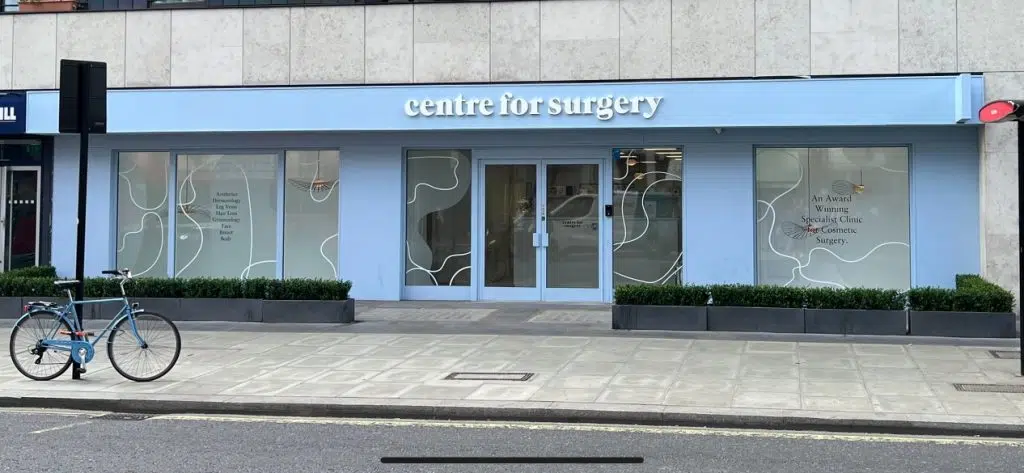It is a frequently asked question among women at Centre for Surgery in London: Can you breastfeed with breast implants? The answer is a resounding yes! It is indeed possible to breastfeed with breast implants, but there are a few factors to consider. In this comprehensive article, we will delve into the topic of breastfeeding with breast implants, addressing all your queries about breastfeeding and breast surgery.
Breastfeeding with Implants – An Overview
Breastfeeding after undergoing breast implant surgery is generally feasible. However, its success may depend on the size and placement of the implants. For most women, the presence of breast implants does not significantly affect milk production. However, it is worth noting that some individuals may experience a decrease in milk supply.
Physical Changes to Expect
It is normal for your breasts to undergo changes in size and shape following breastfeeding. While breastfeeding does not typically impact the implants themselves, the breast tissues may expand and contract, causing alterations in breast size and shape. Later in this article, we will explore the specific changes that may occur to breast implants after pregnancy.
RELATED: Breastfeeding After a Boob Job
Breastfeeding with Breast Implants – Is it Possible?
One of the concerns that many women have when considering breast augmentation is how it may impact their ability to breastfeed. In this article, we aim to provide you with important information about breastfeeding with breast implants.
Procedures such as breast augmentation, breast lift, and breast reduction can potentially affect the nerves and ducts within the breast, which can have an impact on lactation. It is worth noting that certain procedures may have a more pronounced effect on breastfeeding than others. Therefore, if you are planning to have a baby in the future, it is generally recommended to wait until after completing your family before undergoing these procedures.
However, we understand that circumstances may not always align with these recommendations. You may have had breast implants prior to having children, and it is important to be aware that this can pose challenges when it comes to breastfeeding. The presence of breast implants can lead to compression of milk ducts and nerves, potentially making breastfeeding more difficult. The size and weight of the implants can also influence the likelihood of encountering breastfeeding difficulties.
It is essential to note that there are women who may struggle to produce milk regardless of whether they have breast implants or not.
A recent study published in a prominent Plastic Surgery Journal shed some light on this matter. The study concluded that a woman with aesthetic breast implants has a 3 in 4 chance of being able to breastfeed if desired, regardless of the type and volume of the implant and the surgical approach. Moreover, the study found that there is a higher probability of successful breastfeeding with retromuscular implants compared to retroglandular implants. This suggests that the placement of the breast implants plays a significant role in breastfeeding after breast augmentation.
Breast Implant Placement Options and Breastfeeding Considerations
When it comes to breast implant surgery, there are two primary options for implant placement: above or below the muscle. While both options are generally safe, it is important to understand the differences between them, as they can impact breastfeeding with implants.
One of the potential risks associated with breast implants is their impact on milk flow. This occurs because the presence of implants can exert pressure on the milk ducts, rather than the surgery itself causing disruption. The risk of breastfeeding difficulties is higher with above-muscle implants.
Above the Muscle Placement
Above-the-muscle implants, also known as retroglandular or sub-glandular implants, are positioned behind the breast tissue and in front of the pectoral muscle. Due to this placement, they can compress the milk ducts and nerves, increasing the likelihood of breastfeeding challenges.
Under the Muscle Placement
Under-the-muscle implants, also referred to as retromuscular or submuscular implants, are positioned below the pectoral muscle, providing additional support to the breasts. Consequently, they are less likely to compress the milk ducts and nerves. This means that women with under-muscle implants generally have a higher chance of successful breastfeeding.
At Centre for Surgery in London, our surgeons prefer to place breast implants under the muscle whenever possible. This approach offers several advantages, including a more natural appearance, lower risk of complications, and improved suitability for breastfeeding.
If you are considering breast implants and have future plans for breastfeeding, we strongly recommend consulting with a specialist plastic surgeon at our Centre for Surgery. They will be able to assess your individual circumstances, discuss the available options, and provide tailored advice to help you make informed decisions regarding your breast implant surgery.
Breast Surgery and its Impact on Breastfeeding
It is important to note that certain types of breast surgery can pose challenges to breastfeeding. These procedures include breast reduction surgery, inverted nipple surgery, breast lift surgery, and mastectomy. However, in most cases, the surgery itself does not affect milk production or disrupt milk ducts.
If you have undergone breast augmentation, the chances of being able to breastfeed with implants are generally favourable. During breast augmentation, the milk ducts remain intact. However, it is worth noting that larger implants can potentially compress the milk ducts, which may make breastfeeding more challenging.
Mastectomy is a more extensive form of breast surgery that typically involves the complete removal of breast tissue. In such cases, it is highly unlikely that you will be able to breastfeed after undergoing a mastectomy. It is important to mention that our surgeons at Centre for Surgery commonly perform FTM Top surgery, which includes double incision mastectomy as part of the procedure.
In the case of inverted nipple surgery, the procedure itself should not impact your ability to breastfeed. However, there is a possibility that the surgery may cause damage to the milk ducts. It is worth noting that the expertise and experience of the surgeon play a significant role in minimising the likelihood of such outcomes.
If you have undergone breast lift or breast reduction surgery, there is a potential for difficulties with breastfeeding. These procedures involve repositioning the nipple, which can potentially result in damage to the milk ducts and nerves. Therefore, some women who have had breast reduction surgery may experience challenges in breastfeeding.
If you have concerns about breastfeeding after breast surgery, we strongly recommend consulting with a specialist plastic surgeon at Centre for Surgery. They will be able to provide personalised guidance, assess your specific situation, and discuss the potential impact of the surgery on your breastfeeding journey.
Can you breastfeed after a breast lift?
The impact of a breast lift on breastfeeding largely depends on the surgical technique used and individual factors. In some cases, the milk ducts and nerves may remain intact, allowing for successful breastfeeding. However, there is a possibility that the surgery can disrupt or damage the milk ducts, which may lead to difficulties with milk production and breastfeeding.
Can You Breastfeed After a Breast Reduction?
It is possible for some women to breastfeed after undergoing breast reduction surgery, but there are several factors to consider.
During breast reduction surgery, the nipple-areola complex is repositioned, which can potentially affect milk ducts and breastfeeding. The risk of milk duct damage is higher when the areola is made smaller and moved to a higher position. However, experienced surgeons take precautions to preserve the blood supply, nerves, and milk ducts as much as possible.
Research studies have shown that when the nipple-areola complex remains attached during breast reduction surgery, all women have the potential to breastfeed successfully. When the complex is partially intact, breastfeeding success rates decrease to around 75 percent. In cases where the nipple complex is completely detached as part of a free nipple grafting procedure, the chances of successful breastfeeding drop to around 5 percent.
While some studies indicate a high probability of breastfeeding success if the nipple remains attached, it is not possible to guarantee breastfeeding outcomes for individual cases. Surgeons typically inform patients about the potential risk of being unable to breastfeed after breast reduction surgery. Breast reduction and breastfeeding present a risk that all patients should be aware of before undergoing the procedure.
If you are considering breast reduction surgery and have concerns about breastfeeding in the future, it is crucial to discuss your goals and expectations with a qualified plastic surgeon at Centre for Surgery. They can evaluate your specific situation, explain the potential risks and limitations, and provide personalised advice based on their expertise and experience.
Top Tips to improve milk supply for breastfeeding mothers
Improving milk supply can be a common concern for breastfeeding mothers. Here are some top tips to help increase and maintain milk supply:
Frequent and Effective Breastfeeding
Breastfeed your baby frequently and on demand. The more often your baby breastfeeds, the more signals your body receives to produce milk. Ensure your baby is latching properly to ensure effective milk transfer.
Establish a Good Breastfeeding Routine
Establishing a consistent breastfeeding routine can help stimulate milk production. Try to breastfeed at similar times each day, including nighttime feedings.
Empty the Breasts
Make sure to empty both breasts during each feeding session to signal your body to produce more milk. Offer both breasts at each feeding or switch breasts midway if your baby is still hungry.
Breast Compression
During breastfeeding, try gentle breast compressions to help stimulate milk flow and encourage your baby to continue feeding.
Ensure Proper Hydration and Nutrition
Stay well-hydrated by drinking plenty of water throughout the day. Follow a balanced diet that includes foods rich in nutrients important for lactation, such as whole grains, leafy greens, lean proteins, and healthy fats.
Breastfeed Skin-to-Skin
Practice skin-to-skin contact with your baby while breastfeeding. This closeness helps stimulate milk production and enhances the bonding experience.
Avoid Pacifiers and Supplemental Bottles
Minimise the use of pacifiers and bottles, as they can interfere with the demand and supply cycle of breastfeeding. Direct breastfeeding is the most effective way to stimulate milk production.
Avoid Skipping Feedings
Try to avoid skipping or delaying feedings whenever possible. Regular and frequent breastfeeding sessions are essential for maintaining milk supply.
Seek Support
Reach out to a lactation consultant or breastfeeding support group for assistance. They can provide guidance, tips, and personalised advice to help improve milk supply and address any breastfeeding concerns you may have.
How to Fix Saggy Breasts After Breastfeeding
After breastfeeding, some women may experience changes in breast shape and firmness, often characterised by sagging or drooping breasts. Here are some options to help address saggy breasts after breastfeeding:
Supportive Bras
Wearing well-fitting, supportive bras can help lift and provide better support for saggy breasts. Look for bras with full cups, wide shoulder straps, and underwire if desired.
Breast Exercises
Certain exercises can help strengthen the muscles underneath the breasts, which may improve their appearance. Examples include chest presses, push-ups, and dumbbell flyes. Consult with a personal trainer or physiotherapist for guidance on specific exercises suitable for you.
Maintain a Healthy Weight
Fluctuations in weight can contribute to changes in breast shape and firmness. Aim to maintain a healthy weight through a balanced diet and regular exercise to help preserve breast tissue elasticity.
Moisturise and Hydrate
Regularly moisturies the breast area to help improve skin elasticity. Drinking plenty of water also helps maintain overall skin hydration.
Topical Treatments
Some creams and lotions claim to firm and tighten the skin. Look for products containing ingredients like retinol, hyaluronic acid, collagen, or elastin.
Consider a Breast Lift (Mastopexy)
If sagging is significant and bothersome, a breast lift surgery may be an option. This procedure involves removing excess skin, reshaping the breast tissue, and repositioning the nipples to achieve a more lifted appearance. Consult with a plastic surgeon at Centre for Surgery to discuss the suitability of a breast lift for your specific situation.
RELATED: How To Treat Sagging Breasts After Breastfeeding
Frequently Asked Questions – Breastfeeding with Breast Implants
Q: Can I breastfeed with breast implants?
A: Yes, it is generally possible to breastfeed with breast implants. However, some women may experience a decrease in milk production compared to those without implants. Opting for breast implant placement underneath the muscle may increase the chances of successful breastfeeding.
Q: What do implants look like after breastfeeding?
A: Breast implants themselves are not affected by breastfeeding. However, some women may notice changes in breast shape due to the loss of skin elasticity during pregnancy and nursing. This can result in sagging or a lower appearance of the breast implants. If this concerns you, breast implant replacement surgery may be a suitable solution.
Q: How long should I wait after breastfeeding before getting breast implants?
A: Most doctors recommend waiting at least six months after you stop breastfeeding to allow your body to recover from pregnancy and nursing. It is important to wait until your breasts have reached their final size and shape before considering breast implant surgery. This precaution can help minimize the need for additional surgeries in the future.
Q: Can breastfeeding with breast implants harm my baby?
A: No, breastfeeding with breast implants does not harm your baby. The risk of breast milk contamination from implants is low. Even in the case of a ruptured implant, silicone leakage into breast milk is unlikely. If you have concerns about breastfeeding with a ruptured implant, it is recommended to undergo an MRI and consult with your plastic surgeon for appropriate advice.
Q: Will breastfeeding ruin my implants?
A: No, breastfeeding itself will not ruin your breast implants. While breastfeeding may cause changes in breast shape, it does not directly impact the implants. However, in some cases, women may experience implant movement after breastfeeding, particularly if they have a history of smoking or large breast size. If this occurs, surgical intervention may be necessary to reposition the implants.
Q: How can I restore my breasts after breastfeeding?
A: It is important to understand that it may not be possible to completely restore your breasts to their pre-breastfeeding appearance. However, over time, the size and shape of your breasts may return to some extent. This process can take several months to a few years, so patience is key. If you are still dissatisfied with the appearance of your breasts after a few years, surgical options such as a breast lift may be considered.
Why choose Centre for Surgery?
At Centre for Surgery, we strive to provide exceptional care and expertise in the field of plastic and cosmetic surgery. Here are some reasons why you may choose Centre for Surgery:
Specialist Plastic Surgeons
Our Baker Street clinic is staffed by highly skilled and experienced plastic surgeons who have undergone rigorous training in their respective fields. They are board-certified and have a wealth of knowledge and expertise in various surgical procedures.
Comprehensive Range of Procedures
Centre for Surgery offers a wide range of plastic and cosmetic surgical procedures, including breast augmentation, liposuction, facelift, rhinoplasty, and many others. We aim to cater to the diverse needs and desires of our patients, providing tailored treatment plans to achieve their desired outcomes.
Personalised Approach
We understand that every patient is unique, and we prioritize individualised care. Our surgeons take the time to listen to your goals, concerns, and expectations. They provide detailed consultations, discussing available options, risks, and benefits, to ensure you are well-informed and comfortable with your decision.
State-of-the-Art Facilities
Our clinic is equipped with modern, state-of-the-art facilities and technology to ensure the highest standards of patient care and safety. We prioritize creating a comfortable and welcoming environment for our patients throughout their surgical journey.
Commitment to Safety
Patient safety is our utmost priority. Our surgeons follow stringent safety protocols and adhere to industry best practices. We ensure that our surgical techniques and procedures are up-to-date, minimising risks and maximising outcomes.
We understand that choosing a plastic surgery clinic is an important decision. We encourage you to schedule a consultation by calling us on 0207 993 4849 with one of our specialist plastic surgeons at Centre for Surgery to discuss your specific needs and goals.














